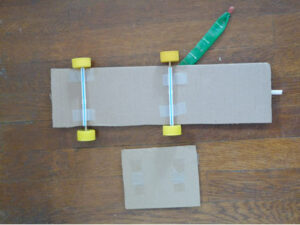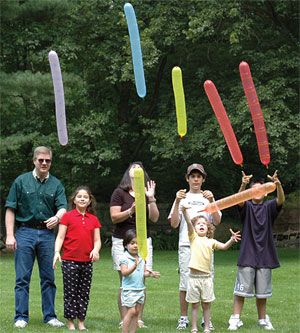 by: Norman Barstow
by: Norman Barstow
When the National Research Council produced the National Science Standards in 1995, they did so without including sets of lesson plans nor did they design them as part of a standard curriculum package. They were written to be used as goals for our students’ achievement in science.
In my classroom I always used the National Standards when designing my lessons, and they were always clearly represented in the objectives I set for my students. I have found that the topics of Force and Motion, as well as Air, (as part of a weather unit), can be easily taught using balloons to demonstrate the concepts of each. I have designed two different lesson activities that can be used to meet the following standards.
National Science Standards
Content Standards: K-4
Physical Science; Content Standards
- An object’s motion can be described by tracing and measuring its position over time.
- The position and motion of objects can be changed by pulling or pushing. The size of the change is related to the strength of the push or pull.
National Science Standards
Content Standards: 5-8
- The motion of an object can be described by its position, direction of motion and speed.
- An object that is not being subjected to a force will continue to move at a constant speed in a straight line.
- If more than one force acts on an object along a straight line, then the forces will reinforce or cancel one another, depending on the their direction and magnitude. Unbalanced forces will cause changes in the speed or direction of an object’s motion.
- Energy is transferred in many ways.
Balloon Rockets
In a recent workshop I attended, which presented a module on Air and Weather, ‘Balloon Rockets’ was an activity used to show that compressed air can exert pressure to propel a balloon rocket.
The activity used a straw threaded through fishing line, which was stretched across the room. A ziplock bag was then attached to the straw, and the inflated oblong balloons were launched by placing them into the open bag. The force produced by the balloon propelled the straw along the fishing line.
I noticed that the balloons tended to make the bag move from side to side, thus decreasing the distance traveled. We tried the activity again using balloons directly attached to the straw with masking tape. The oblong balloon traveled much farther than the ziplock bag attempt. Next, I introduced the Educational Innovations Rocket Balloons.
What a difference, both in distance traveled and speed. The Rocket Balloons release the compressed air steadily from the opening of the balloon to the weighted tip thereby pushing the straw farther along the fishing line.
Rocket Balloon Powered Car
Another recent discovery I made in my basement was a compressed air (balloon powered) car that I saved from an NSTA workshop I had once attended. The ‘car’ was built with a piece of cardboard as the frame and an axle system made using a wooden skewer inside a drinking straw. The ‘wheels’ were bottle caps and the ‘engine’ was a straw with a balloon attached.

While the oblong and/or round balloons worked fine, I wanted to try the EI Rocket Balloon. I had to modify the ‘car’ to account for the increased length and mass of the rocket balloon. The new chassis was now 4 X 14 inches, and I moved the wheels accordingly for this ‘super sized’ car. Again, the difference increased significantly in both distance and speed.
In addition to meeting the above National Standards, these are perfect experiments for elementary and middle school students on manipulating variables and testing hypotheses using the scientific method.

how do I get extra pumps and how much are they
We don’t actually sell the pumps separately, but for every package of 40 Rocket Balloons, you get a pump. The cost is $12.95. I think you may be able to get the pumps separately from a party supply store. Hope that helps.
~Tami
Educational Innovations